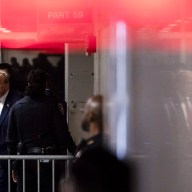Eat, drink, hit. These are the rules of the NFL. No, seriously. Just take a look at any team locker room.
A league-mandated sign outlining and illustrating illegal hits is the last thing Jets players see before slipping onto the field at both their practice facility and New Meadowlands Stadium. The sign, which hangs right next to posts about hydration and a healthy diet, warns against aiming for the head or leading with the helmet.
“I heard a player say that he didn’t know how to tackle if he didn’t use his head to do so. I want to find his high school coach and give him a talking-to,” said Jim Tunney, who was an NFL?referee for 31 years. “We have to have this rule. Today’s player is bigger, faster and stronger and he’s not trying to just tackle someone, he’s trying to run through him. That makes the guy with the ball a target, not just something to stop.”
Defenders, though, want to stop the refs from throwing flags on players who aren’t aiming with their helmets.
Take last Thursday for example, when the Jets were twice called for illegal hits on the Bengals.
They’re not set to overtake Frank Vincent’s character in the movie “Casino” for dishing out the most hits to the head, but the Jets continue to be plagued by inconsistent helmet-to-helmet calls.
Following the Week 6 hit by the Steelers’ James Harrison on Browns wide receiver Mohamed Massaquoi, the league had sent around a memo not just warning off players from targeting offensive players at the head but also warning against players from leaning into the tackle with their helmet. But then incidents like last Thursday night happen which leads to frustration from the players who get flagged.
“I actually kind of curled up, I wasn’t trying to lean in with my head. I was actually trying to protect myself,” said cornerback Drew Coleman, who “illegally” popped receiver Jordan Shipley. “The receiver had Eric Smith on his back and I was going in for the tackle, and I think he was sort of dragging forward. I didn’t want to get hit myself, so I sort of curled up.”
Yesterday, Coleman still wasn’t sure why he was flagged for that play, and like an overwhelming amount of players, still doesn’t fully understand the inconsistency in calls.
After the play, Coleman turned toward the sideline to “mess with the crowd,” trying to get them louder and more involved in the game. The flag came and Coleman’s first instinct was that a scuffle happened off the ball and someone was getting penalized for fighting.
“Honestly, I didn’t even know I hit him with the face guard or my helmet,” Coleman said. “I was just trying to read his eyes the whole time.”
The league is concerned about the use of the helmet, in particular, in leading with tackles. Penn State’s octogenarian coach Joe Paterno said following the Harrison hit that he was concerned about the facemask becoming a “weapon.”
“Take the face mask off these players then see how they tackle. It won’t be head first, I can tell you that much,” Tunney said. “The face mask has become a weapon, it’s not about protection any more. It is something used to hit and hurt someone else.”
In the third quarter, Jets safety James Ihedigbo was called for roughing Cincinnati quarterback Carson Palmer on a hit that neither appeared late or as if “Digs” was intentionally leading with his head. As Palmer changed his position in anticipation of the hit, Ihedigbo ended up hitting the Bengals quarterback with his helmet.
“It was one of those things where I wasn’t going for him with my head,” Ihedigbo said. “But he changes his body’s position and instead of hitting him with my shoulder like I was trying to do, I got him with my head. That wasn’t my aim.”
And the player’s “aim” is important for Tunney and something he wants to stress to his former colleagues.
“Sometimes it will happen where a player who wasn’t intending to hit with his head will end up hitting with his head and he’ll get called for it. That’s very tough,” Tunney said. “That’s when you have to look at the player’s intent and try to gauge if he’s leading with his head and was lining up that way. But in the game as a referee, you only have a millisecond to make the call and it’s incredibly tough to make that call.”
Coleman said that the play isn’t something he’s been addressed about by the coaching staff and that the team doesn’t spend time in practice focusing on the proper way to hit.
“With the speed of the game, things will happen. We know how to hit, how to tackle and use the shoulder,” Coleman said. “But sometimes in the course of the game, things just happen like that play. It’s unfortunate, I’m just glad that it didn’t cost us the game, but it’s tough because it wasn’t what I was trying to do.”
















